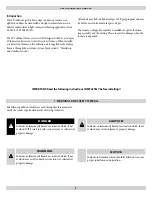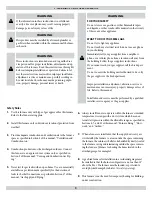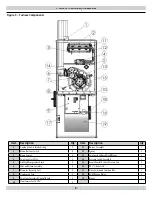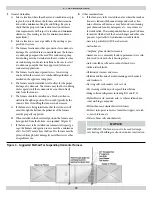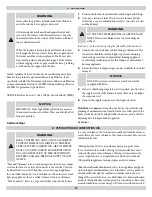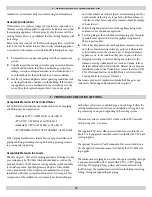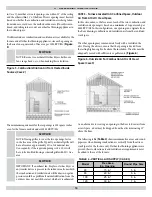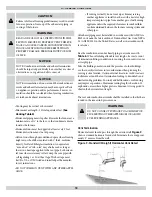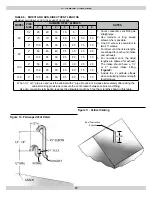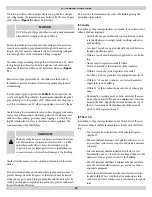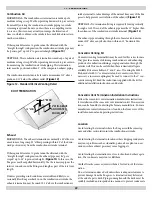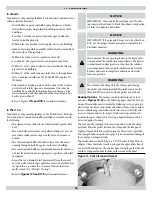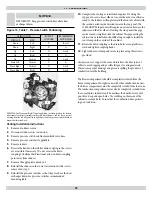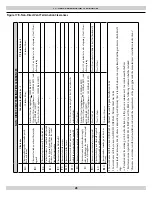
combustion systems must not be vented into single wall metal vents.
General Considerations
If this furnace is to replace a Category I type furnace connected to a
chimney serving other appliances, steps must be taken to ensure that
the remaining appliances will vent properly aft er the removal of the
existing furnace. Th
ere is a probability that the existing chimney will
be too large.
Remove the vent connector of the furnace being replaced, seal off the
inlet to the vent from that furnace, then test the remaining applianc-
es connected to the common vent individually following these steps:
1.
Permanently seal any unused openings into the common vent
system.
2.
Visually inspect the venting system for proper size and horizon-
tal pitch and determine that there is no blockage, restriction,
leakage, corrosion, collapsed materials such as fallen bricks, or
any other defi ciency that could lead to an unsafe condition.
3.
Insofar as practical, duplicate winter operating conditions such
as closing all windows and doors in the building. If the remain-
ing appliances are in a mechanical room, close the door to the
room. Close the fi replace dampers if any, turn on any appli-
ances that exhaust air to the outdoors on maximum speed. Th
is
would include clothes dryers, range hoods, bathroom fans, etc.
Attic fans or other fans used only in summer should be exempt-
ed from the test.
4.
Follow the lighting instructions of the appliance being tested
and turn it on to continuous operation.
5.
Test for spillage at the draft hood relief opening aft er 5 minutes
of main burner operation. Detect for spillage using a match
fl ame, taper (candle).
6.
Aft er it has been proven that each appliance to remain connect-
ed to the common venting system properly vents when tested
as listed above, return the windows, doors, fi replace dampers,
appliances, etc. to the condition they were in prior to the test.
7.
If improper venting is observed during any of the tests, the
common venting system must be re-sized. In Canada, refer to
the latest addition if CAN/GGA-B149, Natural Gas or Propane
Installation Code. In the United States, refer to the latest ANSI
Z223.1 National Fuel Gas Code (NEPA 54), or AGA-GAMA
Venting Tables for Category I furnaces.
Th
e furnace products of combustion include both fl ue gases and
condensate. All venting and drain materials are plastic.
Acceptable Materials In The United States
For United States installations, the combustion air and vent piping
and fi ttings may be comprised of:
• Schedule 40 PVC, ASTM D1785 or CSA B137.3
• PVC-DWV, ASTM D2665 or CSA B181.2
• Schedule 40 CPVC, ASTM F441 or CSA B137.6
• PVC PRIMER AND SOLVENT CEMENT: ASTM D2564
Follow piping manufacturers instructions on proper installation of
piping and fi ttings including cutting, de-burring, priming, cement-
ing, curing and supporting.
Acceptable Materials In Canada
Eff ective August 1, 2007, all vent piping materials and fi ttings for fl ue
gas venting must be ULC S636 listed and identifi ed as such on the
material. Th
e fi rst 3ft . (900mm) of venting must be readily available
for visual inspection. Specifi ed primers and glues of the certifi ed
vent system must be from a single system manufacture, and not
intermixed with other system manufacture’s vent system parts. Th
e
components of the certifi ed vent system must not be interchanged
with other vent systems, or unlisted pipe, and or fi ttings. Follow the
venting manufacturers instructions on installation, cutting, de-burr-
ing, cementing, curing and supporting of the venting system.
Th
is furnace can be vented with ULC S636 certifi ed PVC material
with a rating of 65º C or more.
Th
e supplied PVC street elbows are certifi ed for use within the ves-
tibule. Use the approved transition cement certifi ed by the ULC S636
venting supplier.
Th
e optional Concentric Vent Termination Kits are certifi ed for use.
Use the approved transition cement certifi ed by the ULC S636 vent-
ing supplier.
Th
e combustion air piping does not have fl ue gases traveling through
it and may be installed with common ABS, PVC or CPVC piping
or fi ttings. Th
is piping, fi ttings, primer and cement will need to be
installed as per the manufacturers instructions including cementing,
cutting, curing and supporting the piping.
8 - VENTILATION AND COMBUSTION AIR
9 - VENTING AND COMBUSTION AIR PIPING
14



